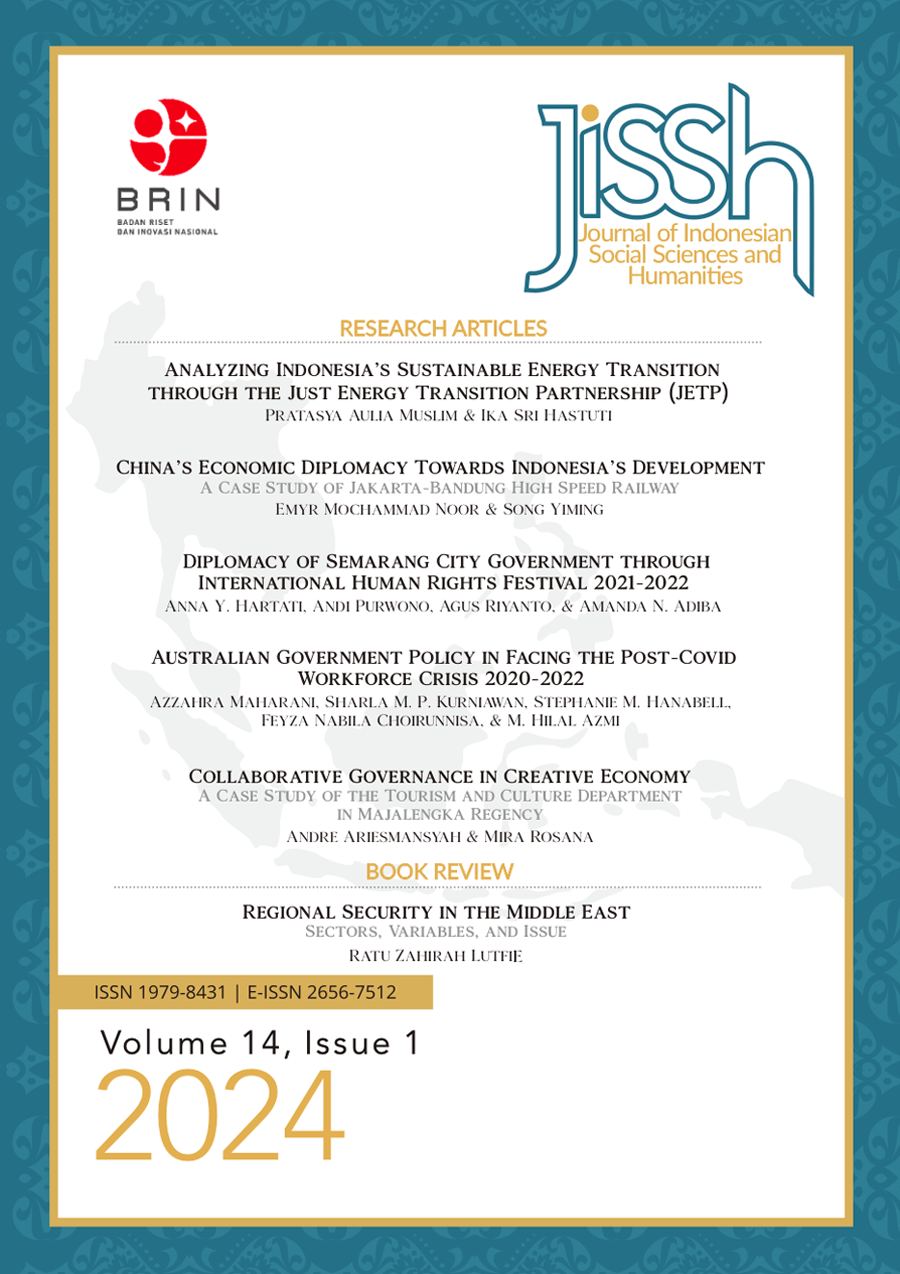Collaborative Governance in Creative Economy: A Case Study of the Tourism and Culture Department in Majalengka Regency
Keywords:
Collaborative Governance, Governance Assesment, Creative Economy, Tourism, CultureAbstract
The results of this study indicate that the Collaborative Governance Assessment process in the development of the creative economy at the Tourism and Culture Office of Majalengka Regency is progressing well. This success is attributed to the region's potential to develop creative industry facilities, particularly in the performing arts sector. The research concludes that the Collaborative Governance Assessment process in fostering the creative economy within the Department of Tourism and Culture of Majalengka Regency has been effective. Collaboration with various stakeholders, including creative economy actors and sponsors, has yielded positive outcomes and aligned with the expected targets. Furthermore, this collaboration has the potential to nurture young talents, paving the way for further advancement of the creative economy in Majalengka Regency.
References
Ansell, C., & Gash, A. (2008). Collaborative governance in theory and practice. Journal of Public Administration Research and Theory, 18(4), 543–571. https://doi.org/10.1093/jopart/mum032
Ariesmansyah, A., Ariffin, R. H. B., & Resspati, L. A. (2023). Collaborative governance in tourism village development. El-Riyasah Journal, 14(1), 58–72. https://doi.org/10.29313/riyasah.v14i1.1234
Ariesmansyah, A., Arisanti, I., & Rahmawati, R. (2024). The effect of employee support policy effectiveness, collaborative leadership, and work rewards on organizational innovation in the manufacturing industry in West Java. West Science Social and Humanities Studies, 2(4), 599–609.
Chosuma Arrozaq, D. L. (2016). Collaborative governance: A study of stakeholder collaboration in the development of Minapolitan areas in Sidoarjo Regency. Thesis.
Creswell, J. W. (2010). Research design: Pendekatan kualitatif dalam perspektif. Yogyakarta: PT Pustaka Pelajar.
Diani, & Simbolon. (2017). Analysis of the implementation of collaborative governance in the management of Lava Tour disaster tourism. Social Sciences Forum, 44(1), 43–54. https://doi.org/10.15294/fis.v44i1.9858
Emerson, K., Nabatchi, T., & Balogh, S. (2012). An integrative framework for collaborative governance. Journal of Public Administration Research and Theory, 22(1), 1–29. https://doi.org/10.1093/jopart/mur011
Ginting, A. M. (2017). The development strategy of the creative economy in the West Java province. Study, 22(1), 71–88.
Howlett, R. (2002). Integrating human capital concepts in productivity and growth topics. Journal of Management Research, 2(1), 22–42.
Jones, P., Comfort, D., Eastwood, I., & Hillier, D. (2004). Creative industries: Economic contributions, management challenges, and support initiatives. Management Research News, 27(11), 134–145. https://doi.org/10.1108/01409170410784315
Majalengka Regency Regional Regulation Number 8 of 2021. Master plan for tourism development of Majalengka Regency for 2021–2025. Retrieved from https://ppid.majalengkakab.go.id
Ratner, B. (2012). Collaborative governance assessment. World Resources Institute. Retrieved from https://www.wri.org
Saputra, D. (2020). Collaborative governance of community-based tourism village development. Government: Journal of Government Science.
Spillane, J. J. (1991). Ekonomi pariwisata: Sejarah dan prospeknya. Yogyakarta: Kanisius.
Sudarmo. (2009). Elemen-elemen collaboration leadership dan hambatan-hambatan bagi pencapaian efektivitas collaboration governance. Jurnal Spirit Publik, 15(2), 117–132. https://doi.org/10.29313/spiritpublik.v15i2.543
Suherman, D., Aliya, S., Ariesmansyah, A., & Khaulani, D. G. (2022). Patrakomala as Bandung City Government innovation in reorganizing the creative economy post-COVID-19 pandemic. Publica: Journal of Public Administration Thought, 14(2), 145–158.
Downloads
Published
Issue
Section
License
Copyright (c) 2024 Andre Ariesmansyah, Mira Rosana

This work is licensed under a Creative Commons Attribution-ShareAlike 4.0 International License.
Authors who publish with this journal agree to the following terms:
1. Authors retain copyright and grant the journal right of first publication with the work simultaneously licensed under an Attribution-ShareAlike 4.0 International (CC BY-SA 4.0) license. This license allows others to remix, adapt, and build upon the work, as long as they credit the author and license their new creations under the same terms.
2. Authors may enter into separate, additional contractual arrangements for the non-exclusive distribution of the journal’s published version of the work (e.g., posting it to an institutional repository or including it in a book), provided there is an acknowledgment of its initial publication in this journal.
3. Authors are permitted and encouraged to post their work online (e.g., in institutional repositories or on their personal website) prior to and during the submission process, as this can lead to productive exchanges and increase citations of the published work (See The Effect of Open Access ).


















